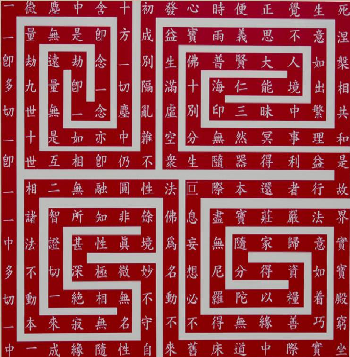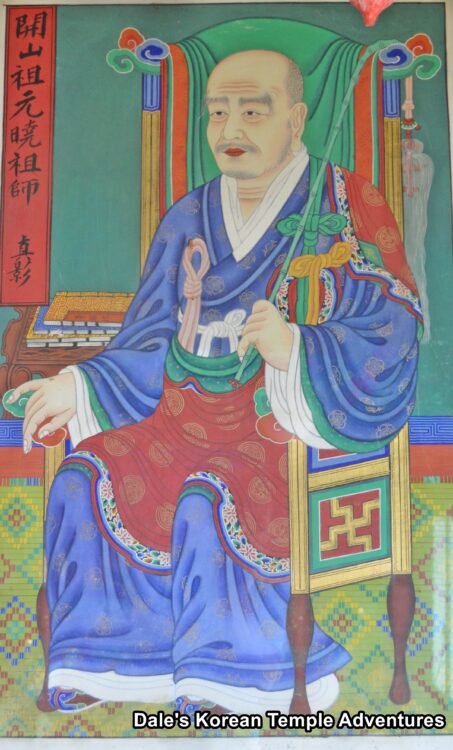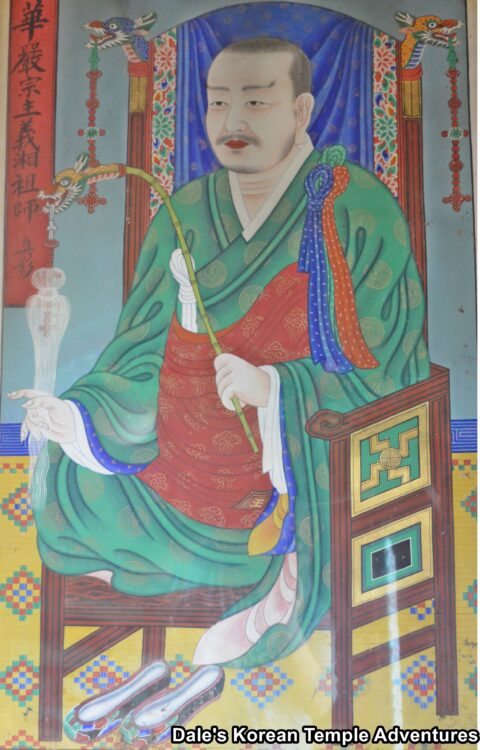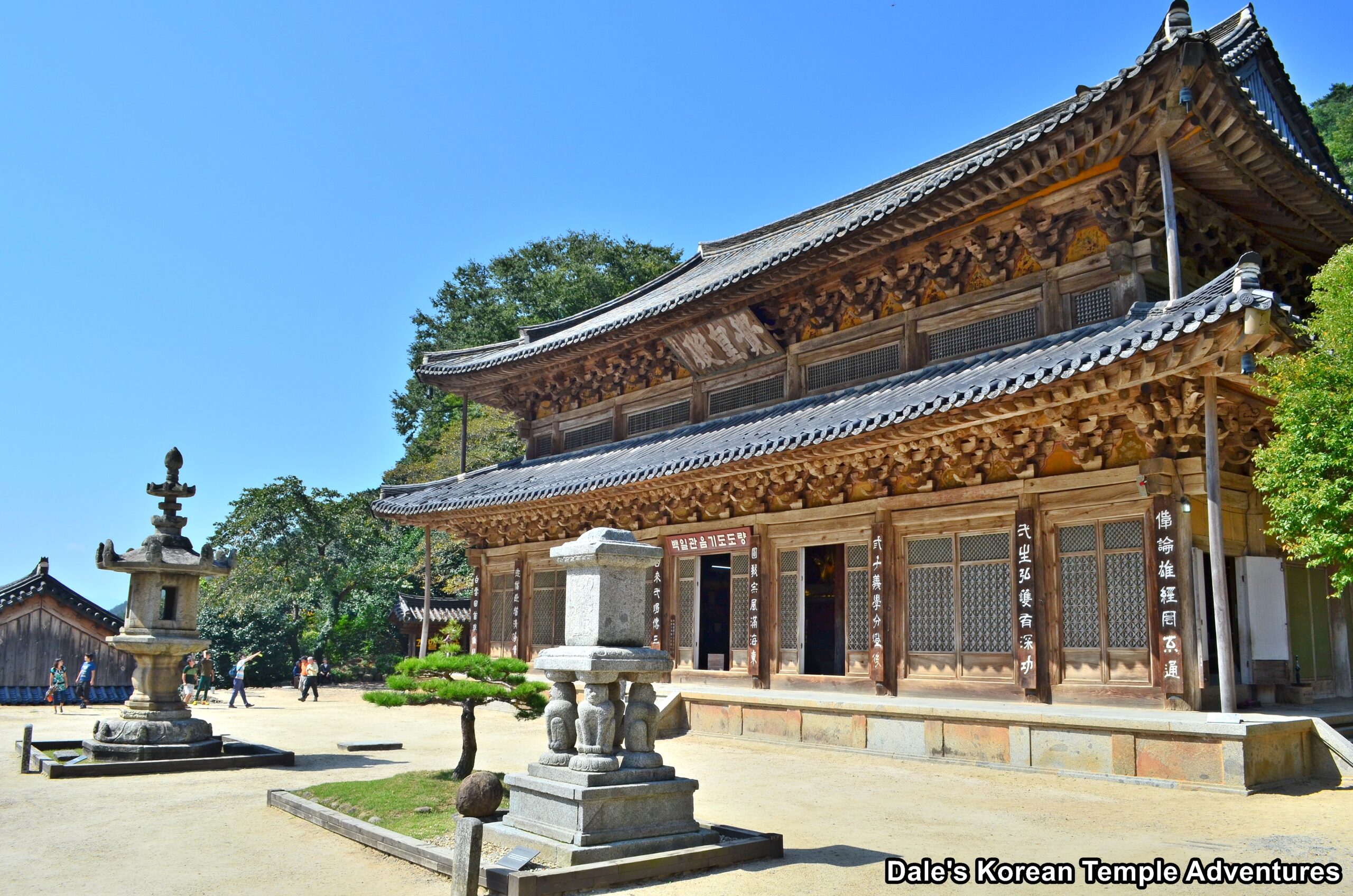Hwaeom-jong – Huayan Sect: 화엄종

The Hwaeom sect is the name of the Korean transliteration of the Huayan school of Chinese Buddhism. Huayan uses the Avatamsaka Sutra, or “Flower Garland Sutra” in English, as their primary text. In Korean, this sutra is known as the Hwaeom-gyeong – 화엄경, which is a reference to the idea that the Flower Garland is meant to be the crowning glory of the Buddha’s understanding of ultimate reality.
The founding of the Huayan school is traditionally attributed to the Five Patriarchs, who were instrumental in the development of the school’s teachings. These five are: 1. Dushun (557-640 A.D.), 2. Zhiyan (602-668 A.D.), 3. Fazang (643-712 A.D.), 4. Chengguan (738-839 A.D.), 5. Guifeng Zongmi (780-841 A.D.).
It was from Zhiyan that the visiting Uisang-daesa (625-702 A.D.) learned the Huayan school teachings. Upon his return to the Silla Kingdom (57 B.C. – 935 A.D.) in 671 A.D., Uisang-daesa transmitted the teachings throughout Silla. This resulted in the establishment of the Hwaeom sect. Originally, when the sect was established, it was one body. Only later did it become two separate streams. The first of these two streams, rather obviously, was established by Uisang-daesa who had traveled to Tang China (618–690, 705–907 A.D.) and directly learned and studied under Zhiyan. The other, independently, but influenced by Uisang-daesa, was founded by Wonhyo-daesa (617-686 A.D.), who also just so happened to be Uisang-daesa’s close friend. These two streams, together, would form the original Hwaeom sect of Buddhism. So while Uisang-daesa was a direct disciple of Zhiyan and the Huayan school, Wonhyo-daesa would attempt to solve the contradictions found in the Huayan teachings through metaphysical exploration.
Wonhyo-daesa’s stream of Hwaeom would be known as the Haedong Sect, the Bunhwang Sect, and/or the Wonhyo Sect. Uisang-daesa’s stream would be known as the Buseok Sect, or the Uiji Sect. So what are the differences and commonalities found between these two streams of the same sect?

A: The Haedong Sect
The Haedong Sect was first founded during the reign of King Munmu of Silla (r. 661-681 A.D.) by the famed Wonhyo-daesa (617-686 A.D.). The sect is also known as the Bunhwang Sect because that’s the temple, Bunhwangsa Temple in Gyeongju, where he lived and taught during the majority of his lifetime. In 661 A.D., both Uisang-daesa and Wonhyo-daesa attempted to travel to Tang China after a first failed attempt in 650 A.D. Both were attempting to further their Buddhist studies. In Liaodong, which was a part of the Baekje Kingdom (18 B.C. – 660 A.D.), they needed to take shelter in a cave during a strong storm. During the night, Wonhyo-daesa became thirsty, so he reached out to a gourd filled with water to quench his thirst. After drinking the cool water, and feeling refreshed, he fell back asleep. Waking the next morning, the two monks discovered that they had in fact taken shelter inside an ancient tomb that was filled with skulls. And instead of drinking from a gourd from the night previous, Wonhyo-daesa had in fact drank dirty water from one of the skulls. Upon realizing this, Wonhyo-daesa vomited. After recovering, Wonhyo-daesa came to realize just how much power the mind had to transform reality. So while afterward, Uisang-daesa continued on to Tang China, Wonhyo-daesa returned to the Silla Kingdom to teach what he had learned.
Upon his return to the Silla Kingdom, Wonhyo-daesa would write various commentaries like “The Awakening of Faith in Mahayana.” He would also write the “Treatise on Reconciliation of Disputes in Ten Approaches.” With these commentaries, Wonhyo-daesa was attempting to reconcile and answer the differences found in Buddhism and the human condition.

B: Buseok Sect
The Buseok Sect, on the other hand, which was already mentioned, was founded by Uisang-daesa. Uisang-daesa would continue on to Tang China despite Wonhyo-daesa leaving him after Wonhyo’s enlightenment. Uisang-daesa would learn under, and be guided by, Zhiyan. Rather interestingly, while Uisang-daesa was learning under Zhiyan, Zhiyan gave Uisang-daesa the nickname of “Uiji,” which means “Meaning Maintainer” in English. That’s why the Buseok Sect is also sometimes known as the Uiji Sect, as well. And the main reason that the Buseok Sect is known as such is because the main seat of the Buseok Sect was maintained at Buseoksa Temple.
So after leaving Wonhyo-daesa, Uisang-daesa would continue on towards Tang China, where he studied at Zhixiang Temple on Mt. Zhongnan under Zhiyan. It was from Zhiyan that Uisang-daesa would learn the Hwaeom teachings. Upon his return to Silla in 671 A.D., Uisang-daesa would build Buseoksa Temple in 677 A.D. under royal orders to help promote the Hwaeom teachings. Uisang-daesa taught the teachings of Hwaeom to some three thousand disciples before dying in 702 A.D. It was in 1101 that Uisang posthumously earned the title of “Great Saint, National Preceptor of the Perfect Teaching,” or “Daeseong Wongyo-guksa” in Korean.
A rather unique feature to the Hwaeom sect is what is known as the “Ocean Seal,” or “Haein” in Korean. This Ocean Seal is also known as the “Ocean Seal Diagram,” or “Haein-do” in Korean. This is based upon the Ocean Seal Samadhi, or “Haein Sammae,” in Korean, which is contained in the Avatamsaka sutra. It’s believed that if one enters this stage of meditation, the three worlds, which are known as “Samgye” in Korean, which represent the material world, the world of living beings, and the world of the Buddha, will suddenly appear to the individual. It’s also said that if one were in the middle of a great sea, all things existing here on earth and up above in the heavens would appear suddenly all together as if they were imprinted on a great seal in the middle of a boundless sea. That’s why this is called the “Ocean Seal.”
As for the history behind this seal and the Buseok Sect of Hwaeom, Zhiyan, Uisang-daesa’s master, drew seventy-two graphs of the Ocean Seal and showed them to Uisang-daesa. Uisang-daesa carefully studied each of the seventy-two and made one of his own. When he showed it to Zhiyan, Zhiyan looked at it and said, “This one Ocean Seal of yours is equal to my seventy-two seals. Your Ocean Seal is comprehensive, and mine is partial. The great meaning of Huayan [Hwaeom] does not dwell outside of your seal.” So when Uisang-daesa came back to Silla, the Ocean Seal was adopted as a symbol to help propagate the Hwaeom teachings.
Of all the Gyo sects that were founded at this time during Silla, it was the Hwaeom sect that was the most successful. Besides Buseoksa Temple, other temples that were Hwaeom were Bimarasa Temple in Wonju, Gangwon-do; Haeinsa Temple in Hapcheon, Gyeongsangnam-do; Okcheonsa Temple on Mt. Biseulsan in southern Daegu; Beomeosa Temple in Geumjeong-gu, Busan; Hwaeomsa Temple in Gurye, Jeollanam-do. In total, there were ten of these temples, including Buseoksa Temple, which were known as the Ten Hwaeom Temple Complexes, or “Hwaeom Sipchal” in Korean.
Towards the end of Unified Silla (668-935 A.D.), and the start of the Goryeo Dynasty (918-1392), two great and influential monks would help to continue to promote the Hwaeom teachings. This split would result in two factions. The first was to the south, and it centred around the monk Gwanhye of Hwaeomsa Temple. This would be known as the Southern Peak, or “Namakpa” in Korean. While to the north, the Northern Mountain, or “Bugakpa” in Korean, would be formed under the leadership of the monk Huirang (875-927 A.D.). And the Northern Mountain of Hwaeom would be promoted from Haeinsa Temple.
These two streams of Hwaeom would bitterly fight back and forth over the smallest of details about doctrine. They did this for a long time until the monk Gyunyeo (923-973 A.D.), a Hwaeom monk, reunified and harmonized these two streams of Hwaeom thought. The Hwaeom sect would remain in a position of influence in Gyo Buddhism up until the end of the Goryeo Dynasty, when it was forced to merge with Seon Buddhism. But even within Seon Buddhism, Hwaeom would continue to play an influential role in the growth and development of Buddhism during the Joseon Dynasty (1392-1910) and beyond.
